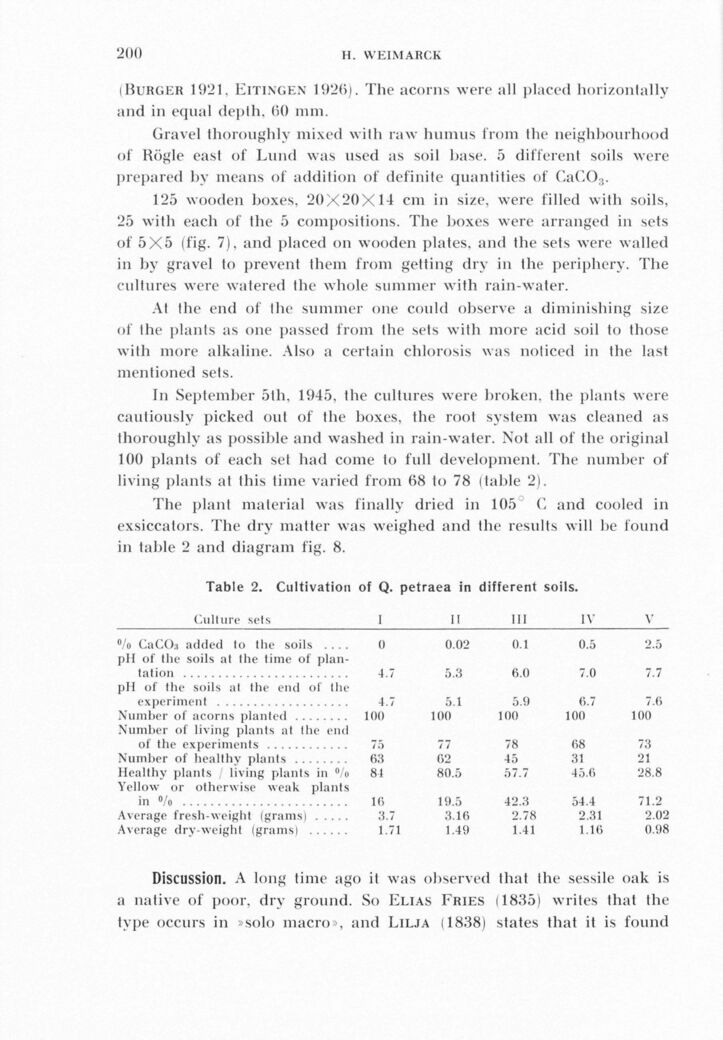
Full resolution (JPEG) - On this page / på denna sida - Sidor ...

<< prev. page << föreg. sida << >> nästa sida >> next page >>
Below is the raw OCR text
from the above scanned image.
Do you see an error? Proofread the page now!
Här nedan syns maskintolkade texten från faksimilbilden ovan.
Ser du något fel? Korrekturläs sidan nu!
This page has never been proofread. / Denna sida har aldrig korrekturlästs.
200
II. WEIMARCK
|Burger 1921, Eitingen 1926). The acorns were all placed horizontally
and in equal depth, 60 mm.
Gravel thoroughly mixed with raw humus from the neighbourhood
of Rögle east of Lund was used as soil base. 5 different soils were
prepared by means of addition of definite quantities of CaC03.
125 wooden boxes, 20X20X1-4 cm in size, were filled with soils,
25 with each of the 5 compositions. The boxes were arranged in sets
of 5X5 (fig. 7), and placed on wooden plates, and the sets were walled
in by gravel to prevent them from getting dry in the periphery. The
cultures were watered the whole summer with rain-water.
At the end of the summer one could observe a diminishing size
of Ihe plants as one passed from the sets with more acid soil to those
with more alkaline. Also a certain chlorosis was noticed in the last
mentioned sets.
In September 5th, 1945. the cultures were broken, the plants were
cautiously picked out of the boxes, the root system was cleaned as
thoroughly as possible and washed in rain-water. Not all of the original
100 plants of each set had come to full development. The number of
living plants at this time varied from 68 to 78 (table 2).
The plant material was finally dried in 105 C and cooled in
exsiccators. The dry matter was weighed and Ihe results will be found
in table 2 and diagram fig. 8.
Table 2. Cultivation of Q. petraea in different soils.
_Culture sets_I_H_III_IV_V_
°/o CaCOs added to the soils ________0 0.02 0.1 0.5 2.5
pH of the soils at the time of
plantation ................................................4.7 5.3 6.0 7.0 7.7
pH of the soils at the end of the
experiment ......................................4.7 5.1 5.9 6.7 7.6
Number of acorns planted ................100 100 100 100 100
Number of living plants at the end
of the experiments........................75 77 78 68 73
Number of healthy plants ................63 62 45 31 21
Healthy plants living plants in °/o 81 80.5 57.7 45.6 28.8
Yellow or otherwise weak plants
in °/i ................................................16 19.5 42.3 54.4 71.2
Average fresh-weight (grams) ..........3.7 3.16 2.78 2.31 2.02
Average dry-weight (grams) ............1.71 1.49 1.41 1.16 0.98
Discussion. A long time ago it was observed that the sessile oak is
a native of poor, dry ground. So Elias Fries (1835) writes that the
type occurs in »solo macro», and Lilja (1838) states that it is found
<< prev. page << föreg. sida << >> nästa sida >> next page >>